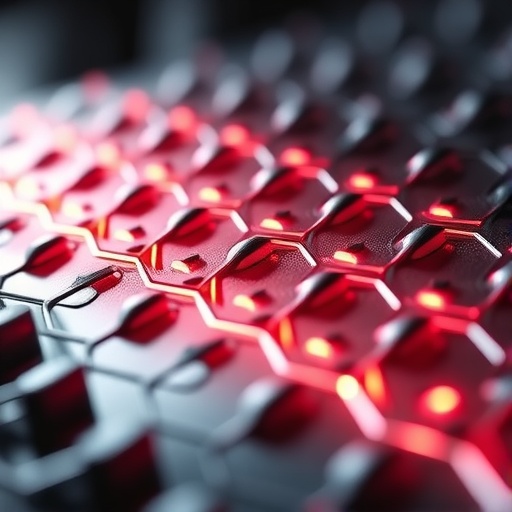Innovative Breakthrough in Bioelectronics: Living Liquid Metal Composites
In an era where technology and biology increasingly intersect, researchers from Binghamton University have unveiled a groundbreaking experimental study that could revolutionize bioelectronics. Led by Professor Seokheun “Sean” Choi, this research centers on the development of living liquid metal composites embedded with electrogenic endospores, presenting a compelling fusion of material science, biology, and electrical engineering. The project, highlighted in the prestigious journal Advanced Functional Materials, aims to harness the unique properties of these composites for next-generation bioelectronic applications.
Liquid metals, particularly gallium-based alloys, have garnered attention for their distinctive characteristics, which include remarkable conductivity and flexibility. These materials can adapt to various shapes and configurations, making them ideal candidates for incorporation into wearable electronics, soft robotics, and even bio-hybrid systems. The Binghamton team has taken this concept a step further by embedding electrogenic endospores within the liquid metal matrix, creating a novel composite that can not only conduct electricity but also interact biologically.
In their experimental research, the team meticulously examined the compatibility of endospores within the liquid metal environment. Endospores are known for their resilience and ability to survive extreme conditions. By integrating them into a liquid metal matrix, the researchers aimed to create a composite that could potentially self-repair and adapt, offering a host of advantages for bioelectronic devices. This self-healing capability could lead to more durable and reliable electronics that are less prone to failure.
One of the key findings of this study is the enhanced electrical conductivity exhibited by the living liquid metal composites. The integration of electrogenic endospores not only improved the conductivity but also contributed to the composite’s biological functionality. The team observed that the composite could produce electrical signals in response to environmental stimuli, paving the way for innovative applications in bioelectronics, such as biosensors and bioactuators that respond dynamically to changes in their surroundings.
The implications of this research extend far beyond traditional electronics. By merging living biological components with advanced materials, the study opens up new avenues in the field of biohybrid systems. Such systems could be used for various applications, including health monitoring, where responsive bioelectronics could detect and relay critical physiological data in real time. The potential for developing smart implants or bio-interfaces that directly communicate with biological systems presents exciting possibilities for future medical technologies.
As the research progresses, the implications for sustainability and environmental impact are also noteworthy. The environmentally friendly nature of the materials involved, combined with the bio-electronic capabilities of the composites, positions this research at the forefront of sustainable technology. The adaptability of the living liquid metal composites might enable the creation of devices that can naturally dissolve when no longer needed, reducing electronic waste and its associated hazards.
Moreover, the innovative techniques employed in this research highlight the interdisciplinary nature of modern science. Researchers from diverse backgrounds, including electrical engineering, materials science, and biological engineering, collaborated to bring this project to fruition. This kind of collaboration is increasingly vital as the boundaries between scientific disciplines continue to blur, facilitating advancements that might have been impossible within traditional frameworks.
Despite the promising results, the researchers acknowledge that further exploration is essential. Future studies will focus on optimizing the mechanical properties of the living liquid metal composites, enhancing the stability and longevity of the electrogenic endospores within the liquid matrix. Additionally, the team intends to examine the interactions between the composites and biological systems more closely, providing a clearer understanding of their potential applications and any safety implications.
The publication of this research marks a significant milestone in the evolution of bioelectronics, as it represents a novel direction in the design of materials that are not only functional but also biologically integrated. Professor Choi’s team is optimistic that their findings will inspire further studies and spark interest among researchers globally, thereby accelerating the development of biohybrid systems that blend the best of biology and technology.
As the field of bioelectronics continues to evolve, breakthroughs like this one will play a pivotal role in shaping the future of electronic devices. Researchers are optimistic that the capabilities of living liquid metal composites can lead to materials that not only perform efficiently but also harmonize with biological environments, contributing to a more sustainable and innovative technological landscape. The journey to unlock the full potential of these composites is just beginning, and the possibilities seem almost endless.
In conclusion, the study of living liquid metal composites represents a bold step toward the future of bioelectronics. With the potential for self-healing and adaptive technologies, these composites could redefine what is possible in wearable electronics and smart medical devices. The incorporation of biological components with advanced materials heralds a new frontier, promising to blur the lines between the living and the synthetic. As research continues in this exciting area, the implications for technology, medicine, and sustainability are profound, paving the way for innovations that could transform lives.
Subject of Research: Not applicable
Article Title: Living Liquid Metal Composites Embedded with Electrogenic Endospores for Next-Generation Bioelectronics
News Publication Date: 24-Oct-2025
Web References: 10.1002/adfm.202521818
References: None Listed
Image Credits: Jonathan Cohen
Keywords
Applied sciences, engineering, Bioengineering, Biotechnology, Bioelectronics.




